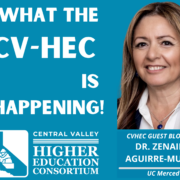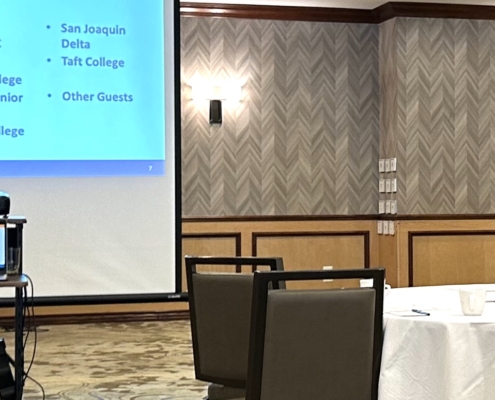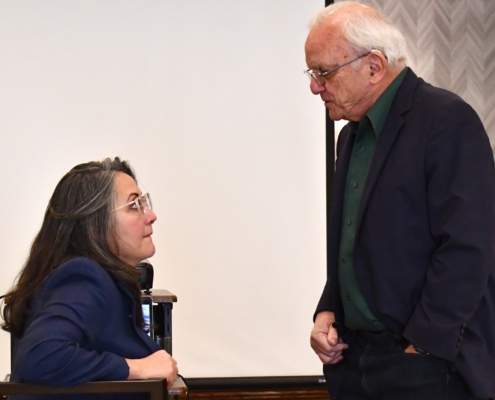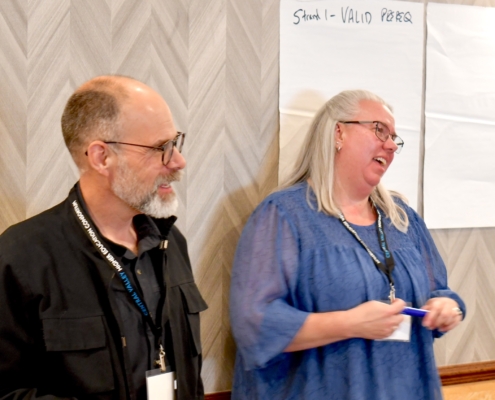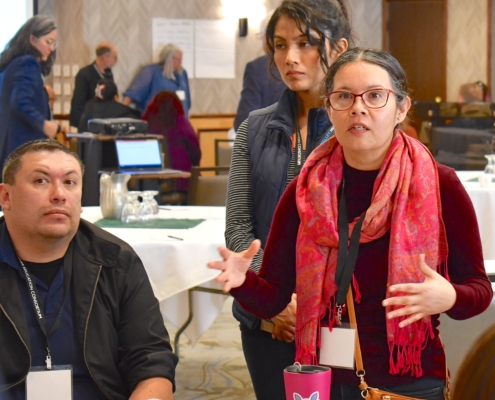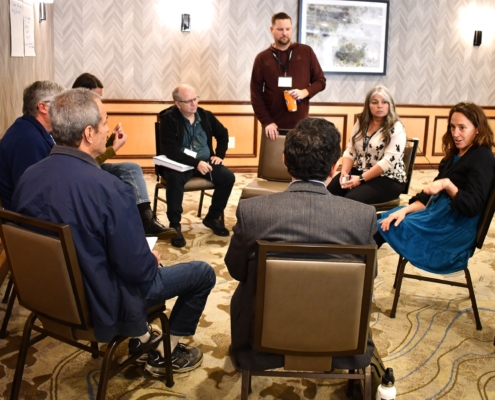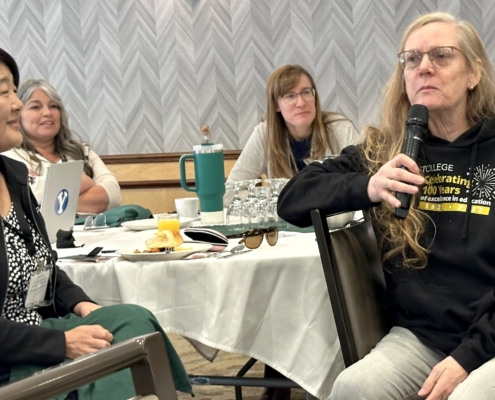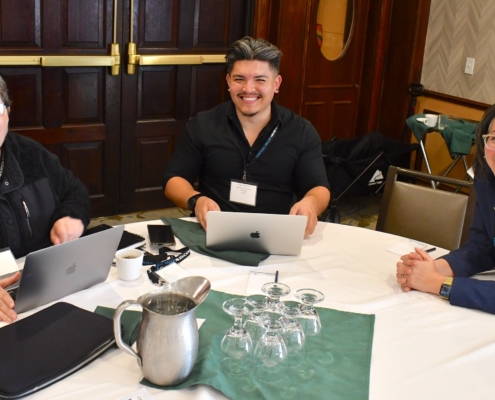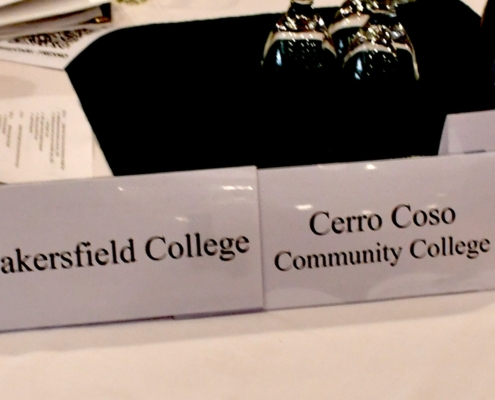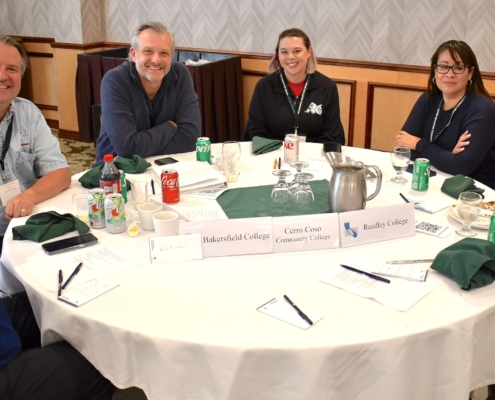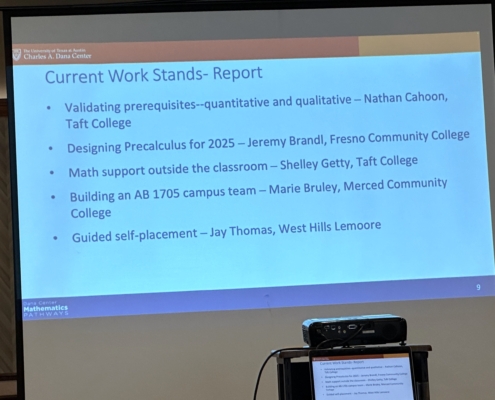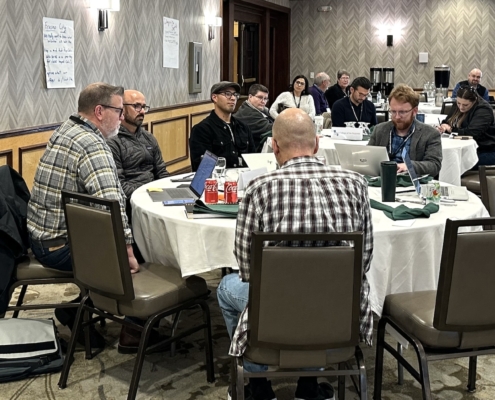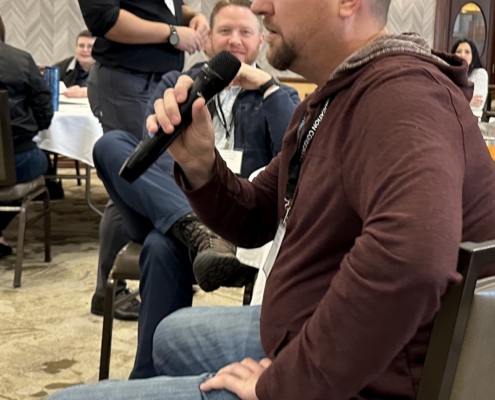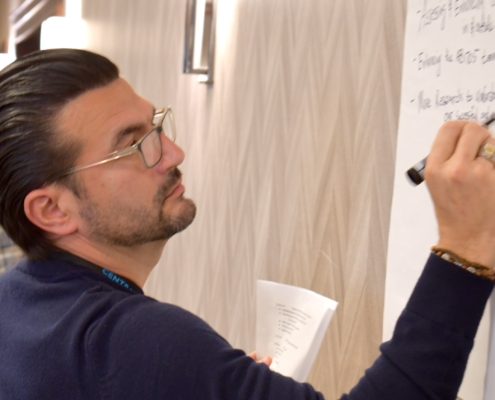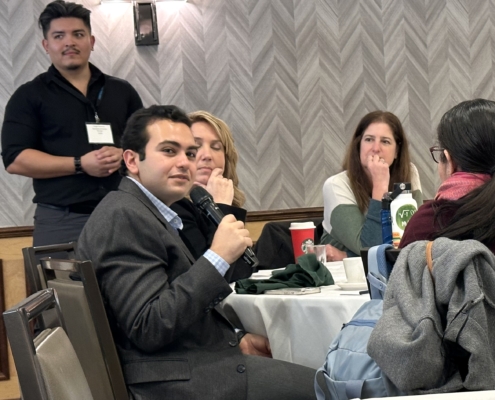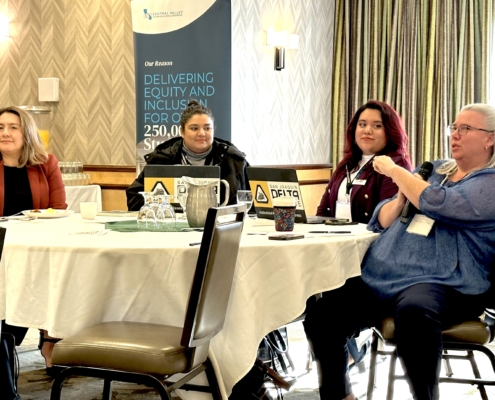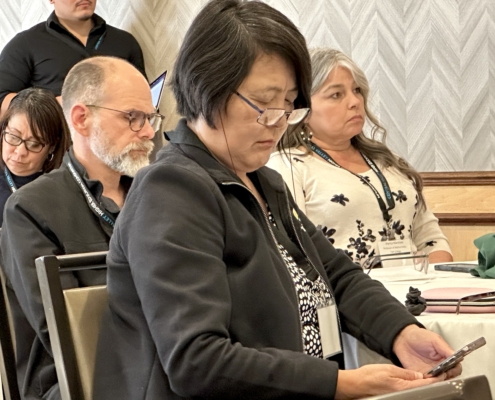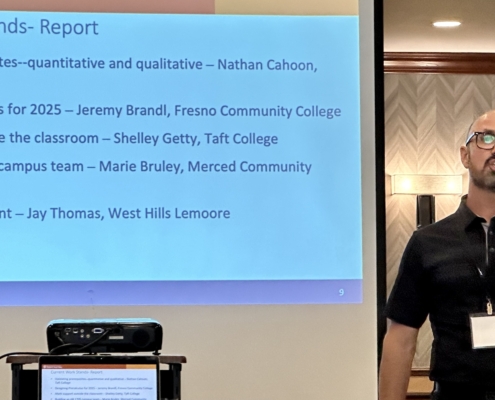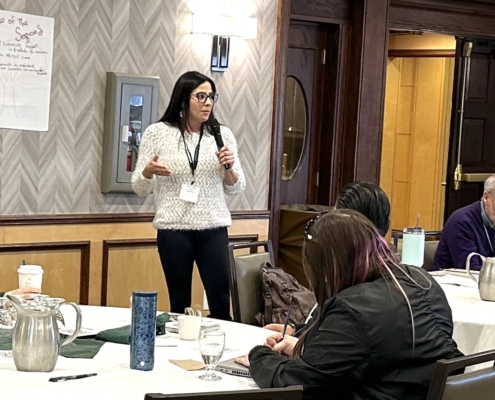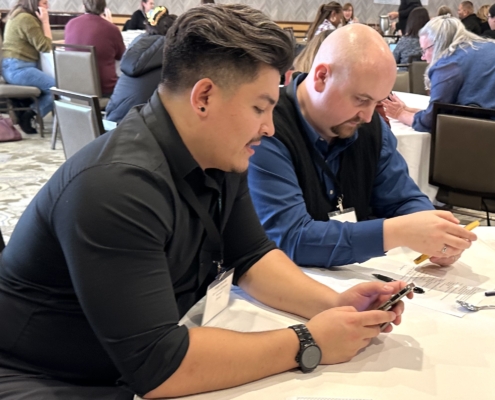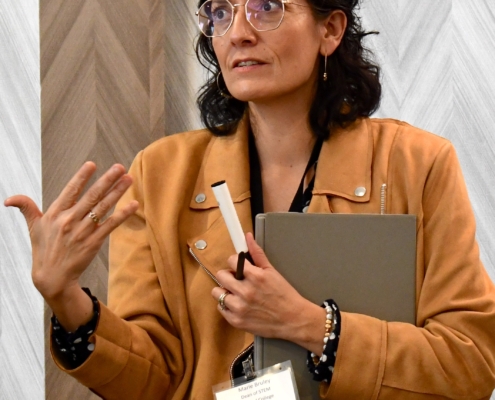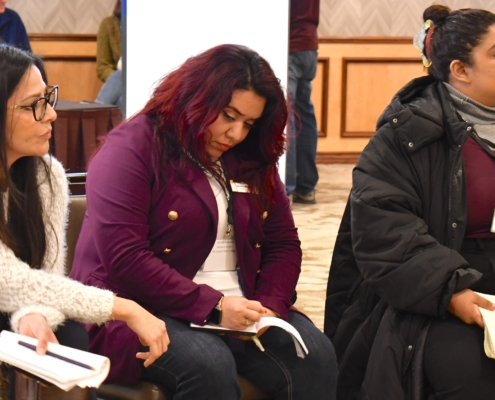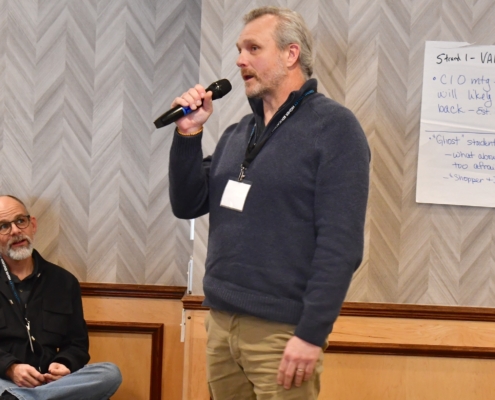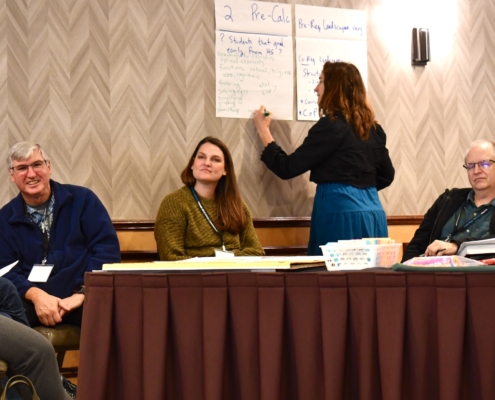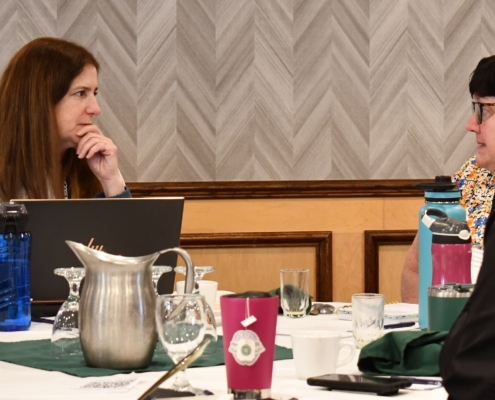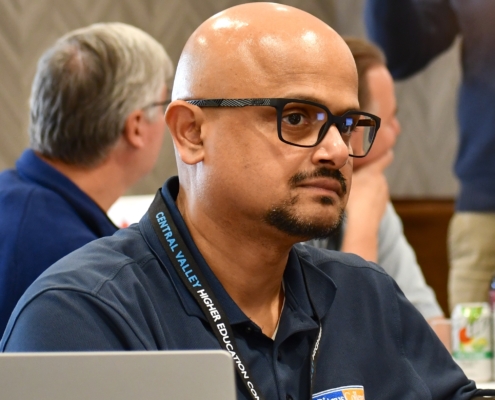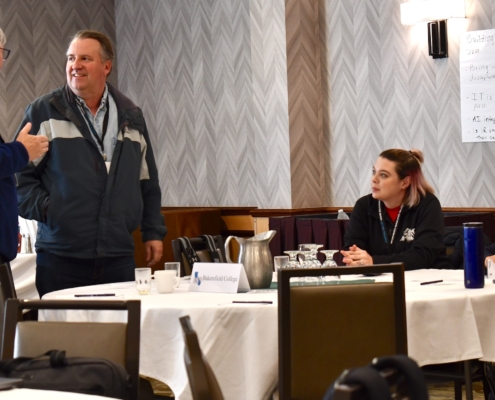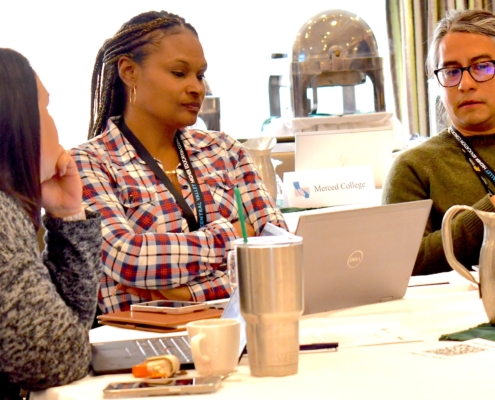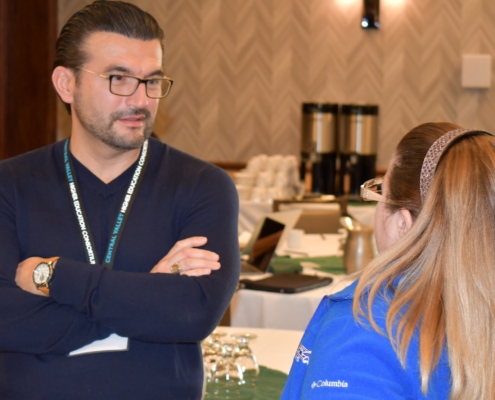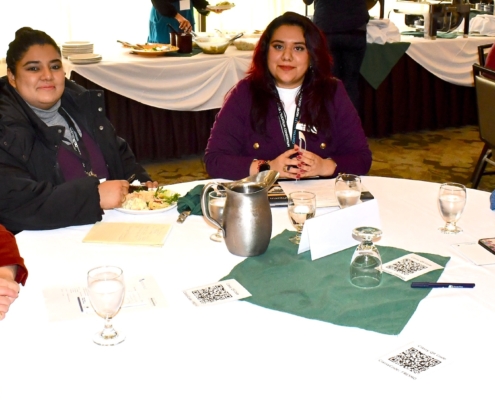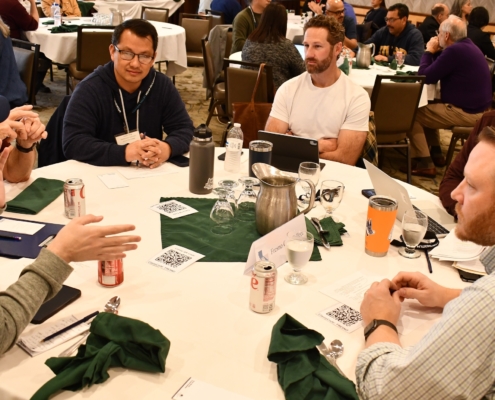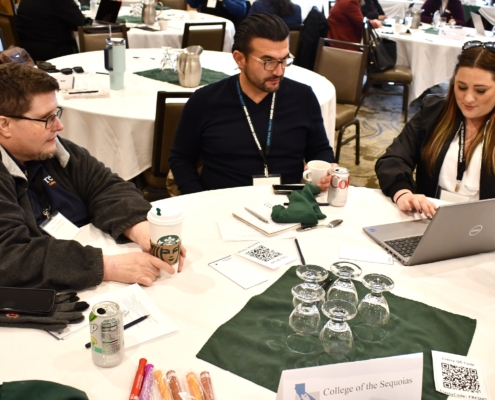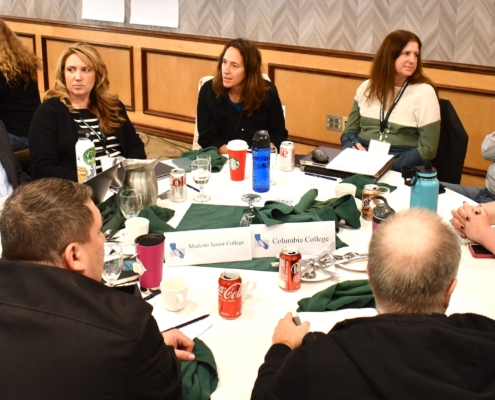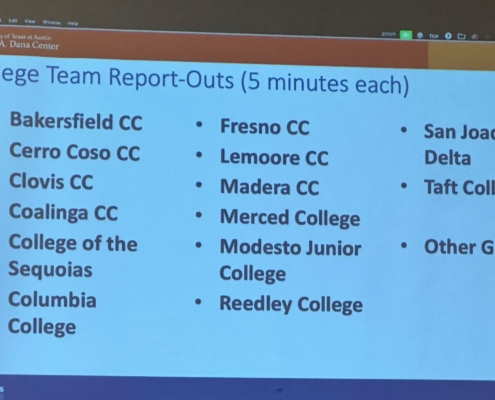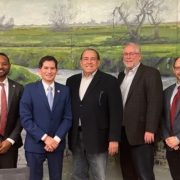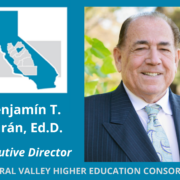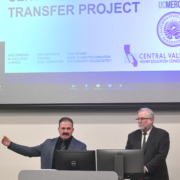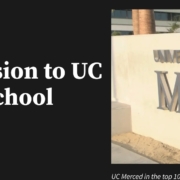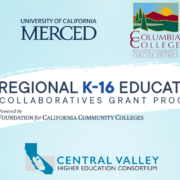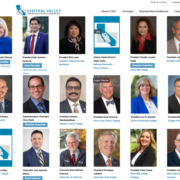MATH TASK FORCE: ‘Something extraordinary’ (Jan. 26 wrap)
Modesto Junior College math professor Tina Akers-Porter discusses her strand group’s deliberations at “The Central Valley Way to AB1705 Success” Convening Jan. 26 where a call for a “principals task force” by Orosi High School Principal Marlena Celaya would bring more secondary education voices to the table.
‘Something extraordinary is happening in math in California’s Central Valley’
Math Task Force latest AB1705 session leads to calls
for more data, high school input, re-convene April 19
BY TOM URIBES
CVHEC Media/Communications Coordinator
Realizing that state guidance surrounding Assembly Bill 1705 remains elusive, valley community college math educators and officials forged ahead at “The Central Valley Way to AB1705 Success” convening Jan. 26 in Fresno with a determined and unified mindset to develop implementation plans that will serve the best interests of their students including a follow-up session set for April.
In addition, the Central Valley Higher Education Consortium (CVHEC) Math Task Force discussion centered around five strands of curriculum planning for implementation before the law goes into effect July 1, two aspects emerged at the lively day-long work session: the increased participation of institutional researchers for pertinent data-collecting and a call for a “principal’s task force” to bring upper secondary education voices to the table.
Presented by CVHEC, the convening — the latest in a series of deliberations since fall — was attended by 82 representatives from the consortium’s 19-member community colleges, one high school principal and campus research professionals.
They agreed to reconvene April 19 for reports on follow-up work that will occur as a result of this most recent event. Registration for that event will open next month with additional details forthcoming.
Facilitated by the Charles A. Dana Center at the University of Texas at Austin, the session last month reviewed five strands of curriculum planning: Validating Prerequisites; Designing Precalculus for 2025; Math Support Outside and Inside the Classroom; Building an AB 1705 Campus Team; and Guided Self-Placement.
“With tensions high and little guidance surrounding AB1705, the 19 community colleges and districts that comprise the CVHEC nine-county region are rolling up their sleeves and getting to work on this math movement the ‘Central Valley Way’,” summarized Tammi Perez-Rice of the Dana Center.
Perez-Rice, who co-facilitated the event, said the convening was solely dedicated to working and planning at a regional and institutional level in two parts. The first part was dedicated to expanding the five work groups that emerged from the Nov. 17 webinar and creating a plan to move forward. The second half of the convening was devoted to institutional planning.
“The fruits produced from these convenings are already being felt around the region,” Perez-Rice said. “The plans and implementations emerging from these convenings are more than just a response to AB705 and AB1705; they cultivate systemic reforms that will benefit all students in the CVHEC region and beyond.”
John Spevak, CVHEC regional coordinator who oversees the consortium’s Math Task Force and co-facilitator of the Jan. 26 gathering, said in the short-term, the five strands work groups will continue to communicate and provide updates in preparation for the April 19 convening. The strand leads are preparing summaries of their Jan. 26 breakout discussions and member college teams are preparing summaries of the tentative plans they developed in the afternoon breakout sessions for oral reports in April.
“In the longer term, our Math Task Force will continue to monitor what the California Community College Chancellor’s Office says, while mainly going forward with our own Central Valley approach to the five strands.”
That “Central Valley Way” stems from the work undertaken by the CVHEC Math task Force, first formed in 2019, in the past year that was intensified with four work sessions beginning Oct. 6 in a virtual convening with CCC vice-chancellor Eric Cooper. The first in-person session followed Oct. 13 in Fresno and another virtual session was held in two parts Nov. 17 before the Jan. 26 session.
These sessions may represent the only concerted effort by a region’s community college math community actively meeting to collaborate across campus boundaries for ways to unite as one voice and determine a curriculum course of action that meets the law’s intent, Spevak said.
“We at CVHEC, along with the Dana Center representatives and our College Bridge partners in the Math Bridge Program, feel that something extraordinary is happening in math in the Central Valley of California,” Spevak said.
After the Jan. 26 session ended, Perez-Rice reiterated a point she made the first time she visited Fresno for the first in-person convening last fall:
“This collaboration today was amazing. As I travel and talk to math faculty all over the country, what I see pulsating from the CVHEC community here in Central California is just compassion; caring about their students; putting their students first; understanding what their students need; and more importantly collaborating with each other working across institutions to make things happen.”
Inviting secondary ed voices to ‘align syllabi’
A key development of the convening was the assertion and agreement that a crucial next step is “to involve high schools in the discussion and determine how to breakdown barriers between systems for a cohesive collaborative effort to put students first across the state of California,” a message delivered by Marlena Celaya, principal of Orosi High School who was the only secondary education official in attendance.
Celaya’s comments, first in a strand session and later in general comments before the assembled group, resonated with the community college professionals as she offered to lead a task force of principals/administrators who would unify with the CVHEC community college math educators for implementation strategy — to listen and hear what the needs are and how to meet those needs.
“I’m willing to lead this work because I don’t want people to go through the wars I went through teaching algebra and volunteering all my time,” said Celaya, a former math teacher at Dinuba High School. “We would want to hear from community colleges and say to them ‘what do you need?’
“We heard something from you today: ‘I want to know what courses are offered at the high school and what does that course description look like?’ Aligning syllabi is what I’d like to do,” Celaya said. “Mathematics is my passion.”
Perez-Rice said the April 19 convening promises more high school representation, with over twelve principals who are part of the Math Bridge Program by CVHEC and College Bridge being invited. Other secondary education officials from throughout the valley are welcome she said.
Participant feedback: ‘great to see we’re not alone in this …’
After the event, several participants shared their assessment of the Jan. 26 convening.
“The conversations were amazing and we really appreciated being here,” said Joshua Lewis, chair of the Bakersfield College Mathematics Dept.
“There have been so many legislative changes and so many unknowns it’s nice to see the work that other campuses are doing and realize that we’re not alone, that we have shared values; that we have shared emphasis on student learning and really care about doing right by all of our students,” he added.
Nathan Cahoon, Taft college math professor, felt that the efforts of CVHEC’s Math Task Force as exhibited at the convening is strengthening the voice of the valley’s math community which will have an impact.
“It was amazing to work with incredible professionals who have some really amazing ideas,” he said. “I know I took many good notes about ideas to implement at our college. The connections we are building here with each other will be powerful down the road as we build a cohesive effort to get some good research together that we can send to the state as one voice from all the colleges.”
Modesto Junior College math professor Marina Hernandez said coming together within the region is relished because when attending other statewide or national conferences, the focus is not as localized.
“It was very helpful to learn what other colleges in the Central Valley are doing because we share similar student population and resources characteristics and their best practices are applicable to us here in our region,” Hernandez said.
Tina Akers-Porter, Modesto Junior College math professor, said the Math Task Force work has helped her better understand what AB1705 is and what it means for her students.
“I feel like I have a better understanding of some of the challenges of the legislation and what others are worried about,” she said. “We share some of those worries but it’s great to hear different points of view on that. A byproduct of this is we are seeing how we need to support underprepared students more, inside and outside the classroom, and sharing ideas to do that.”
Shelly Getty, Taft college math faculty and a strand leader, echoed Akers-Porter: “We left knowing we are going to start some specific tutoring and targeting students for tutoring. We will try to advertise it better and recruit so students get more access to the services we already provide which will greatly impact them. We shared some good ideas on how to do that effectively.”
Marissa Martinez, Taft college math professor, said, “We have our work cut out for us. There’s a lot of things that we have to address with a lot of moving parts. Everything keeps changing but it was great to be able to see that we’re not alone in this, that we’re working together to better serve our students.”
She said this intercollegial collaboration and the feedback from the colleges helps “so we don’t have to reinvent the wheel — what worked, what didn’t work.”
Next steps? Data research
“I would say the next step is collecting our data to see how the numbers show where we are so we can prove that these courses are important for our student success,” Martinez said.
This data aspect was also a key part of the convening as institutional research professionals were invited and directly participated such as Arooj Rizvi, research analyst in the Office of Institutional research and Effectiveness at San Joaquin Delta College.
“Researchers have a monumental role in the implementation of AB 1705 because policymakers are going to depend a lot on what we are able to produce as a group or even as an institution,” Rizvi said. “Being a part of these conversations helps us to see the bigger picture, the context and the requirements of what exactly it is that we are looking for in the data.”
She said it was exciting to hear at the convening what area colleges are going through.
“I realized how similar our challenges are from institution to institution, “she said. “Working through that together and being solution-oriented is something that’s going to take all of us towards a beneficial direction. Seeing us all here today was a defining moment in history.”
Owynn Lancaster, vice president of academic strategy for CVHEC partner College Bridge, said the event was “a huge success seeing folks come together from math to talk about math and really pool their resources to address actual challenges.
“The most powerful focus of change in education is always the educator,” Lancaster said. “I know everything’s heaped on them but in a lot of ways they have the greatest power of the greatest agency for this.”
For more info: centralvalleyhec@gmail.com
For CVHEC media inquiries: Tom Uribes – cvheccommunications@mail.fresnostate.edu (or text 559.348.3278).
See also:
https://bit.ly/MTFconveneKSEE24
Valley’s math ed experts unite to address AB 1705 challenge for student success
The CVHEC Way to Math Success — Implementing AB1705
Math Task Force begins discussion of AB1705 implementation – Nov. 17 next
CVHEC Math Task Force meets in-person Oct. 13 for AB 1705 follow-up
NEWS RELEASE – CVHEC Math Task Force: Impactful legislation (AB 1705) Convenings Oct. 6 & 13
CVHEC Website Feature: Math Task Force Page
PHOTO GALLERY
Central Valley Transfer Project: valley’s four-year colleges collaborating
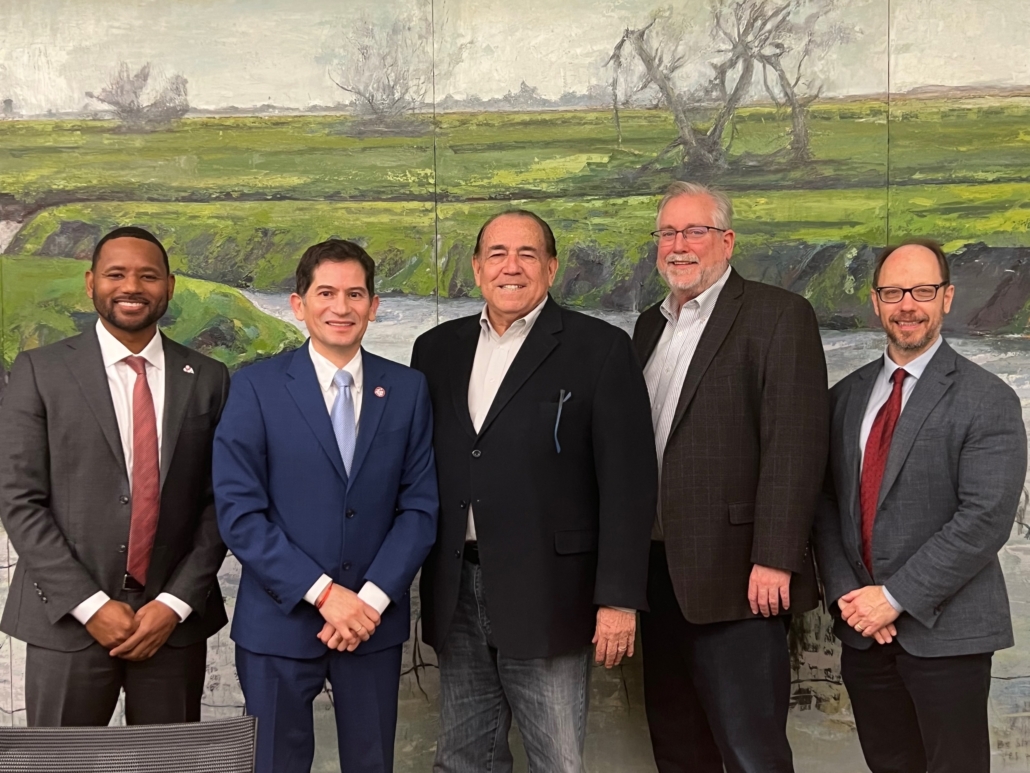
Fresno State, a founding CVHEC member, joined CVHEC’s historic Central Valley Transfer Project in January with (from left): Dr. Kent Willis, vice president of Fresno State Student Affairs and Enrollment Management; University President Saúl Jiménez-Sandoval; Dr. Benjamin Duran, CVHEC executive director; Tom Burke, CVHEC regional coordinator; and Dr. Sergio La Porta, associate dean of the Fresno State College of Arts and Humanities.
Fresno State joins in transfer ‘centerpiece’ with
11 CVHEC community colleges, 3 CSUs, UCMerced
The Central Valley Transfer Project is now partnered with the region’s three California State University campuses after Fresno State signed on in January joining Bakersfield and Stanislaus in the historic Central Valley Higher Education Consortium initiative designed to open new doors for students’ successful transfer from community college.
Along with founding partner University of California, Merced, this means the valley’s four public institutions of higher education are working in unison with 8 community colleges currently through CVHEC’s project using the groundbreaking Program Pathways Mapper software. The project has also gained the full support of the California Community College Chancellor’s Office.
The community colleges already in the CVTP, with several more expected to sign on this year, are: Bakersfield College, Clovis Community College, Madera Community College, Merced College, Porterville College, Reedley College, West Hills College-Coalinga and West Hills College-Lemoore.
The Transfer Project is also expanding participation in the north end of the Central Valley with Modesto Junior College, Columbia College and San Joaquin Delta College scheduled to begin onboard this spring for a total of 11 community college partners said Stan Carrizosa, CVHEC regional coordinator and consortium lead for the project.
All Transfer Project partners are members of the consortium with their respective chancellors and presidents serving on the CVHEC Board of Directors.
“The Transfer Project is now a centerpiece for students to both enter and transfer from community college to their four-year universities,” said Dr. Benjamín Durán, CVHEC executive director. “We are excited to share this latest progress of the project which has been featured statewide and nationally at conferences such as the Community College League of California and Complete College America.”
He added, “This innovative approach is the only one in the state that includes a University of California campus collaborating with partner California State University and community colleges in establishing transfer pathways for Central Valley students to get them to and through college in a timely manner.”
Dr. Saúl Jiménez-Sandoval, Fresno State president and CVHEC board member, said, “I’m proud that Fresno State will be a dynamic partner in the Central Valley Transfer Project, as this pathway will empower community college students to become visionary Bulldogs.”
The Fresno State agreement was finalized Jan. 17 between Durán and President Jiménez-Sandoval, with Tom Burke, CVHEC regional coordinator and Transfer Project team member; Dr. Kent Willis, vice president of Enrollment Services; and Dr. Sergio LaPorta, associate dean of the College of Arts and Humanities.
At CVHEC’s Higher Education Summit last fall, CCC Chancellor Sonya Christian announced that the statewide system has designated the Transfer Project as a demonstration project as set forth in her Vision 2030 for all California community colleges. The Transfer Project’s participating community colleges are serving as the pilot campuses with plans to implement statewide.
Carrizosa said the state budget continues to support and fund the onboarding costs for all community colleges to subscribe to the Program Pathways Mapper.
Established in 2021 with UC Merced, Merced College and Bakersfield College, the project is designed to open new doors for students to successfully transfer from community college with its Program Pathways Mapper, Carrizosa said.
He said the Program Pathways Mapper — a public facing, internet-based app that can be downloaded and accessed by the public software platform — provides unprecedented ease of access for students, counselors, advisors and parents much more so than other existing platforms.
“There are no typical requirements for access to PPM such as other internal college systems like Degree Works, Assist.Org and the CSU Transfer Planner,” he said. “These are all course tracking systems but in order to use them, students need to be successfully enrolled in college and have a student email address or other form of login to try and plan. Through PPM students simply upload the public PPM app to their devices and have immediate access.”
Carrizosa said the PPM helps simplify the transfer planning process which can be the most difficult task for many students.
“In much of our Central Valley region, as many as seven out of 10 incoming college freshmen will be first generation students to attend college,” he said. “Research shows that the most difficult task for them is often the application process itself and completing the required steps for enrollment. Systems like Degree Works and others do nothing to remove this common barrier because these systems cannot be accessed until a student successfully enrolls.”
He explained that a high school student can start the Transfer Project journey as a junior or senior by enrolling in college dual enrollment courses enabling them to complete their transfer level English and Math courses while still in high school. These units roll up with them as they enter community college and track the completion of their lower division requirements for their Associate Degree for Transfer in their chosen major via PPM.
“Students can easily select a community college they wish to attend and a major they want to pursue and the lower division courses required are sequentially laid out for them through the Program Pathways Mapper software.”
In addition, the PPM then links those lower division courses to an upper division institution of the student’s choice and shows a clear sequence of upper division courses needed to complete the degree, Carrizosa added.
“The PPM contains clear and accurate information directly from course catalogues from all participating colleges,” Carrizosa said. “The Central Valley Transfer Project is becoming an alternative continuum of courses to the traditional high school A-G or Career Technical Education continuums and is unprecedented in the state’s community college system. We call it ‘The Central Valley Way!’”
“Through the use of PPM, students complete exactly what is required of them to successfully transfer to their four-year university and they follow PPM through their last two years to degree/certificate completion,” Carrizosa said.
Baseline data results also demonstrate the promise that PPM delivers in the Transfer Project.
In a sample of 5,000 incoming freshmen to Bakersfield College in 2022 the students using the PPM increased their “percentage of on-path course completion” to over 80 percent which also closed the equity gap in this statistic for ethnic minority students when compared to their white counterparts, Carrizosa said.
“The same sample showed students using the PPM reduced the ‘number of units-to-degree’ from an average of 87 down to 67,” he added.
The project is now gearing up to expand the partnership with the College Bridge Math Project and to onboard community colleges from the northern region of the Central Valley.
For more information about the CVTP, contact Carrizosa at centralvalleyhec@gmail.com.
CVHEC media inquiries: Tom Uribes – cvheccommunications@mail.fresnostate.edu or text 559.348.3278.
Fresno State media inquiries: PIO Lisa Bell – lbell@csufresno.edu.
See:
· Pilot CVHEC/UC Merced Transfer Project improves process for students
· CVHEC Web Site Feature: Transfer Project
· Historic Transfer Project spurs statewide movement to increase transfer rates
· HIGHER ED NEWS: College Bridge to expand Math Bridge; CVHEC Transfer Project
• A-G
MEMBER NEWS: 2023 HEED Award Recipients
CVHEC members Fresno State and UC Merced
honored with 2023 diversity award
Two Central Valley Higher Education Consortium members – Fresno State and the University of California, Merced – are among 108 national recipients of the Higher Education Excellence in Diversity (HEED) Award presented annually by The Insight Into Diversity Magazine recognizing colleges and universities that demonstrate an outstanding commitment to diversity.
The oldest and largest diversity publication in higher education recognized Fresno State for a 10th consecutive year. UC Merced, the most diverse in the University of California system, was praised for its efforts to support and strengthen retention and graduation rates for historically underrepresented and first-generation college students.
The HEED recipients are featured in the November/December 2023 magazine issue. Insight Into Diversity magazine advances best practices in diversity, equity, and inclusion (DEI) in higher education.
Through thought-provoking print and online articles, Insight shares expert advice, valuable resources, in-depth profiles of top DEI programs at colleges and universities and headline news to help keep readers informed and empower them to advance DEI initiatives at their institutions.
Created in 2012 the HEED Award is the only national honor to recognize institutions of higher education for their outstanding commitment to diversity, equity, and inclusion.
Fresno State and Stanislaus State are designated Hispanic Serving Institutions.
For details of each member’s award, see:
CVHEC DIRECTOR’S MESSAGE (November 2023)
Chancellor Christian reflects her
commitment to California students
Greetings Colleagues and Friends of CVHEC,
Greetings and welcome to this beautiful fall weather as we prepare for the upcoming holiday season and the end of the fall semester.
We are delighted to report that we are coming off a very successful Central Valley Higher Education Consortium Summit 2023 held at the Fresno convention Center Oct. 20 when we were joined by over 150 of our friends and colleagues to showcase the work of consortium member colleges and universities over the last year.
The highlight of the summit was welcoming our new California Community Colleges Chancellor, Dr. Sonya Christian, home to the Central Valley to serve as our keynote speaker.
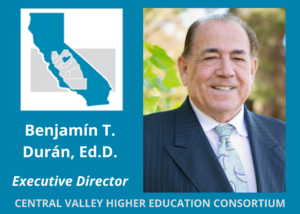 As expected, her presentation was inspiring and reflected her commitment to students in the state. Dr. Christian took this opportunity at the summit to announce and launch the CCCCO Central Valley Transfer Pathways Demonstration Project that will build upon the progress of our own Transfer Project partnership between the community colleges, the CSUs and UC Merced here in the valley. The CCCCO project is unique in California in that it includes the three segments of public colleges and universities and will eventually include the independent universities as well.
As expected, her presentation was inspiring and reflected her commitment to students in the state. Dr. Christian took this opportunity at the summit to announce and launch the CCCCO Central Valley Transfer Pathways Demonstration Project that will build upon the progress of our own Transfer Project partnership between the community colleges, the CSUs and UC Merced here in the valley. The CCCCO project is unique in California in that it includes the three segments of public colleges and universities and will eventually include the independent universities as well.
In this issue’s “What the CV-HEC is happening” blog, you will read an update about CVHEC’s innovative approach to delivering college dual enrollment math courses for high school students throughout the region via our Math Bridge project in partnership with CVHEC partner, College Bridge. The project, designed to get high school students through their first gateway college math course, will serve as a springboard for completing their degrees.
Also please plan on attending the virtual zoom San Joaquin Valley Affordable Internet Adoption Summit on Thursday, Nov. 9, from 8:30 a.m. to 12:30 p.m. The deadline to register is Nov. 7 at: https://bit.ly/SJVSummitRSVP. Bringing affordable broadband internet services to the most vulnerable populations in the Central Valley is an important part of the work CVHEC does in the valley.
Finally, enjoy our summit photo galleries where we share images and comments about the recent CVHEC summit as well as the board meeting and reception they day before. I am sure you will see many familiar faces.
Have a great November and a wonderful and restful Thanksgiving Holiday with family and friends!
Historic Transfer Project spurs statewide movement to increase transfer rates
CVHEC Summit Oct. 20 features Central Valley Transfer Project/Mapper update
BY STAN CARRISOZA, CVHEC Regional Coordinator
President-emeritus – College of the Sequoias
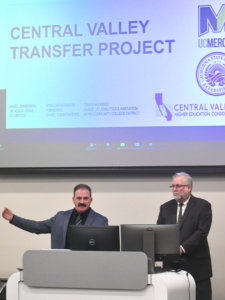
At left, CVHEC Regional Coordinators Stan Carrisoza and Tom Burke present the Transfer Project (Burke is now serving as interim chancellor of the Kern Community College District).
As we enter the third phase of the Central Valley Transfer Project, we are pleased to report great progress has been made ranging from its infancy two years ago to nationwide interest — including possible expansion into another region of California in the near future — as our team is invited regularly to present at state and national conferences.
A presentation and update will be given at the upcoming Central Valley Higher Education Consortium’s 2023 Summit Oct. 20 in Fresno, as well as at conferences in November and December.
Originally born out of dissatisfaction with Central Valley community college transfer rates to University of California, Merced, this effort has spurred a statewide movement at multiple levels to increase the number of successful community college transfers to four-year institutions.
The state budget allowed CVHEC to help the community colleges secure state funding to purchase ongoing access to the software element of the project known as Program Pathways Mapper (PPM).
Recent reporting regarding the California State University and the UC Board of Regents has energized efforts to increase community college transfers and mobilize around successful transfer strategies.
Successful strategies are the foundation of the CVHEC Transfer Project. We have codified simple, straightforward activities for CC and CSU/UC faculty to convene and collaborate to map accessible transfer pathways in numerous discipline majors. In a breakthrough effort by UC Merced, its faculty agreed to review and build on the already successful CSU transfer patterns approved in the Associate Degree for Transfer (ADTs).
Following the pilot project in 2021 with UC Merced, Bakersfield College and Merced College, the CVHEC/UC Merced Transfer project has grown to include several more CVHEC colleges including Porterville, Reedley, Madera, West Hills Coalinga, West Hills Lemoore, Modesto, San Joaquin Delta, Yosemite and Columbia. The project has also included Central Valley four-year institutions CSU Bakersfield and CSU Stanislaus.
Over the past year the project has piqued the interest of the Aspen Institute, the Public Policy Institute of California, the Chief Student Services Officers Association, College Futures Foundation and Complete College America.
Interviews and conferences with these organizations have brought broad exposure to the project and this fall CVHEC will initiate the SoCal Transfer Project being planned to emanate from the North Orange County Community College District. These plans include NOCCCD colleges Fullerton and Cypress to engage with UC Merced, UC Irvine and CSU Fullerton.
As previously reported, early results from the first 5,000 incoming freshmen at Bakersfield College in 2022 shows a strong positive impact from the Transfer Project.
At the core of the project is the Program Pathways Mapper software platform. The ease of access for students, counselors, advisors, HS counselors and parents has proven to be the key factor in success versus other degree auditing software systems.
Among those first 5,000 freshmen tracked, students using the PPM vs. their counterparts not using PPM eliminated the achievement gap among underrepresented students in their On-Path Percentage of courses successfully completed. This significantly reduced their number of units to degree.
We invite interested colleagues and partners to join us in this movement to increase successful transfers by attending our scheduled presentations this fall and winter. In addition to our summit in Fresno later this month, you will find CVHEC’s Transfer team sharing the project at the annual Community College League of California Conference in November and at the Complete College America Conference in December.
For more information: contact Stan Carrizosa at scarrizosa44@gmail.com or visit the Central Valley Transfer Project page on the CVHEC website.
See our full list of Transfer Project stories: Central Valley Transfer Project Archives
See the Central Valley Transfer Project page.
CVHEC DIRECTOR’S MESSAGE (October 2023)
CVHEC Summit panelists bring dynamic convos to the table
Greetings Colleagues and Friends of CVHEC,
We are delighted to welcome you to the October edition of our CVHEC e-newsletter as we enjoy fall in the valley, which is always a special time of the year.
With our 2023 CVHEC Annual Summit, “Student Success through Equity and Inclusion — Thriving in the Central Valley” just around the corner (Friday, October 20), we present our lineup of distinguished panelists and the official agenda. We are especially excited to welcome back to the Central Valley our own Dr. Sonya Christian, newly appointed Chancellor of the California Community Colleges as well as the many CVHEC board members who will introduce and serve on the four dynamic panels we are presenting this year. Dr. Christian, the former chancellor of the Kern Community College District and former CVHEC board member, will serve as our special guest and deliver the keynote address.
 If you have not registered for our no-cost summit yet, please take the time to do so. Join us as we showcase the great work being done by our colleges and universities in our nine-county region that continues to capture state and national attention.
If you have not registered for our no-cost summit yet, please take the time to do so. Join us as we showcase the great work being done by our colleges and universities in our nine-county region that continues to capture state and national attention.
You will hear about and discuss our innovative Math Bridge Project intervention for targeted high school students and our Central Valley Transfer Project, which is providing pathways to our partner universities from our local community colleges (for a preview, see colleague Stan Carrisoza’s Transfer Project update in this issue). The summit also will feature a panel of Central Valley students who have benefited directly from these initiatives.
As always, we also direct you to our “What in the CV HEC is Happening?” Blog that features guest contributors each month. This month we are pleased to share the contribution from Sanger West High School (SWHS) English teacher Jade Martínez.
Mrs. Martinez is amongst the first of our Fresno/Madera K-16 Collaborative Master’s Upskilling grads from National University. This fall, she has taken her new degree into the classroom at SWHS and is delivering her first college English dual enrollment class to her students. This, folks, is what it is all about. Great job Jade!!
We hope to see you on Oct. 20, at the Fresno Convention Center for our CVHEC Summit. Feel free to bring your colleagues and partners (registration).
MEMBER NEWS: UC Merced Automatic Admission Program (MAAP)
UC Merced MAAP partnership creates pathways to success
from high school to higher ed in Central Valley
The University of California, Merced is partnering with several school districts and schools to create an academic pathway for their students that, when satisfied, the student is guaranteed admission* to UC Merced.
Through the Merced Automatic Admission Program (MAAP), high school junior students will submit their application to participate in the guaranteed admissions program by July 1, during the summer before their senior year. Students will be notified to submit their UC application by November 30. Program participants will be prioritized in the application review process and notified of their admissions in February.
Partners – to date
Central Unified High School District
Chowchilla Union High School District
Cutler-Orosi Joint Unified
Dinuba Unified School District
Dos Palos-Oro Loma JUSD
Golden Plains Unified School District
Los Baños Unified School District
Le Grande Union High
Madera Unified School District
Mariposa County Unified School District
Merced Union High School District
Modesto City Schools
Parlier Unified School District
Riverbank Unified School District
Sanger Unified School District
Sacramento City Unified School District
Tulare Unified School District
Visalia Unified School District
See details and MAAP application.
UC Merced Holds Event For Incoming MAAP Students (Slideshow)
See story at www.yourcentralvalley.com.
MEMBER NEWS: North Valley, East Sierra CVHEC members partner for K-16 Collaboratives
State Planning Grants Could Lead to Expansion of CVHEC’s Dual Enrollment Initiatives
Two more Central Valley regions – North San Joaquin and Eastern Sierra – have each been awarded $250,000 state planning grants for the establishment of Regional K-16 Education Collaboratives Grant Programs as part of the statewide drive to strengthen the K-16 education-to-career pipeline. Both collaborative efforts are headed by Central Valley Higher Education Consortium member institutions.
The Department of General Services announced Nov. 9 that the state is awarding the planning grants to the two Central Valley regions as well as the Bay Area and the Central Coast for a total of $1 million. The one-year planning grants will help establish the collaboratives in those areas which will eventually seek additional funding to provide more streamlined, equitable pathways that can help local students transition from high school to college or career training and into the workforce.
In the Northern San Joaquin Region, the University of California, Merced is the lead agency for the newly formed North Valley tri-county Workforce and Education (WE Will!) Regional Collaborative that includes four other fellow CVHEC-members: Merced College, Modesto Junior College, San Joaquin Delta College and California State University, Stanislaus.
They are working in collaboration with partners from Merced, Stanislaus and San Joaquin counties through the WE Will! Collaborative.
For the Eastern Sierra Region, CVHEC-member Columbia College is heading up the K-16 collaborative planning along with several school districts, colleges and employer groups.
These partners will use the planning year to establish their collaborative and to apply together for up to $18 million in state funds available to the region for a three-year “cradle-to-career” pathway project.
These allocations amount to a total of four such collaboratives involving CVHEC members that will help bolster dual enrollment initiatives like the consortium’s successful Master’s Upskilling Program that has already been implemented in the mid valley region through the Fresno-Madera K-16 Collaborative and in the south valley area through the Kern K-16 Collaborative.
The program recruits and helps fund tuition for high school math and English teachers to earn a Master’s so they can teach dual enrollment courses in those subjects on the high school campus.
Dr. Benjamín Durán, CHVEC executive director, said the south and mid valley efforts have laid a solid foundation for the program to succeed when scaled and replicated in the North Valley and Eastern Sierra regions to better serve all Central Valley students.
“As we continue to equitably expand dual enrollment efforts in the Valley, we know one of the barriers for high school teachers to teach these classes is the lack of a master’s degree,” said Duran, president-emeritus of Merced College who was named to lead CVHEC in 2016. “With the new formation of both the WE Will! Regional Collaborative and the Eastern Sierra collaborative with this latest state funding, we will be able to expand our efforts throughout the Valley to increase dual enrollment opportunities for our students.”
In its announcement Nov. 7, UC Merced said the WE Will! Regional Collaborative – which was formed “to address streamlining and accelerating students preparing to enter the priority industry fields that would better serve our region, students and families” — will use the year to assess, design and create a work plan for the phase two application in the fall of 2023, which will be over $18 million.
“UC Merced is committed to helping break workforce barriers,” said Chancellor Juan Sánchez Muñoz who serves on the CVHEC Board of Directors that is made up of the presidents and chancellors of its 30 consortium members from San Joaquin to Kern counties.
“The WE Will! Collaborative between our campus and surrounding counties will be an essential pipeline to build a more equitable future for all students and provide the resources they need to reach their career goals,” the UCM chancellor said.
Dr. Ellen Junn, Stanislaus State president and CVHEC board member, said, “As the California State University serving this region, Stan State is committed to preparing our graduates to address and meet the needs of our regional workforce. We are dedicated to working collaboratively to aggressively pursue equity and diversity in degree and credential attainment as we work to ensure the best possible preparation for student success in the workforce.”
WE Will! provides collaboration between all education partners and the workforce to design ways for students to experience connected learning experiences, acceleration opportunities and successful transition into locally available careers.
“We know employers don’t stop at the county border when they are expanding,” said San Joaquin Delta President Lisa Aguilera Lawrenson, also a CVHEC board member. “We are looking forward to collaborating with our workforce partners and educational partners to get beyond the ‘border’ and plan for the region. Together we can provide a workforce for the needs of today and the future.”
The Eastern Sierra project will also include UC Merced and Stanislaus State as well as K-12, postsecondary, and industry partners, including the superintendents of schools in each participating county, several K-12 districts; and workforce investment boards, including Mother Lode Job Training. Those counties are Tuolumne, Calaveras, Amador, Mariposa, Alpine, Inyo and Mono.
“This is the first step toward a very exciting opportunity for our rural counties,” said Dr. Lena Tran, Columbia College president who is also on the CVHEC Board.
“We are very honored to serve as the lead for a project that will be designed specifically by and for our rural mountain communities. This planning year gives us a chance to build our collaborative and find what works for our students, our schools, and our employers.”
Earlier this year, the state awarded full implementation grants to the Central San Joaquin Valley and Kern County, as well as the North State, Redwood Coast, Orange County, Sacramento, Los Angeles, Border and Inland Empire regions totaling approximately $163 million.
The state grant was awarded through the 2021 Budget Act, which allocated $250 million to the Department of General Services and is being administered through the Foundation for California Community Colleges.
See the UC Merced press release (includes a full list of WE WILL partners) and Columbia College press release.
For CVHEC media inquiries contact Tom Uribes: tom@uribes.com (559.348.3278)
For UC Merced media inquiries, contact PIO Desiree Lopez: dlopez298@ucmerced.edu (209.746.5137)
Presenting our renovated CVHEC Website: Meet our Board of Directors
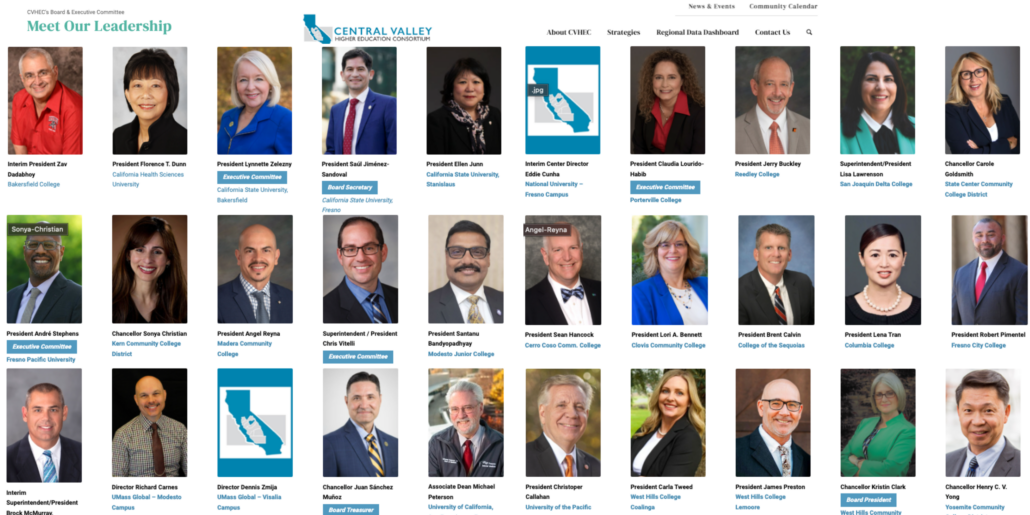
The chancellors, presidents and superintendents of 30 institutions of higher education in the Central Valley nine-county region from Stockton to Bakersfield sit on the CVHEC Board of Directors. They meet quarterly in pursuit of CVHEC’s core mission to increase valley college-going rates and degree/certification attainment, providing a unified voice for their more than 250,000 students served jointly. See the board of directors section in our newly renovated website: https://cvhec.org/about-cvhec/
This fall, we unveil phase one of our renovated Central Valley Higher Education Consortium website which we hope will be easier to navigate as we showcase the work of the Consortium throughout the valley.
We will be featuring a different piece of our website as we continue to build it out in hopes of showcasing it as a resource for our members, colleagues and partners.
This month, we feature the professionals and experts who are carrying out the CVHEC mission. On the “About CVHEC” page, you can meet our CVHEC Board of Directors – the presidents and chancellors of our 30 members of higher education in the Central Valley’s nine-county region from Stockton to Bakersfield as well as the core staff that includes several former educational leaders who now served as CVHEC regional coordinators/liasions,
Also, see our CVHEC News web page that is being finalized this fall featuring our newsletter stories and press releases where news media can connect with us as well as the members of our CVHEC PIO/Communicators Committee, consisting of the communications professionals handling media relations at each of the 30 campuses.
Our new calendar will keep you up-to-date on CVHEC and other higher education events on our radar. For considerations and modifications to our calendar please email centralvalleyhec@gmail.com.

